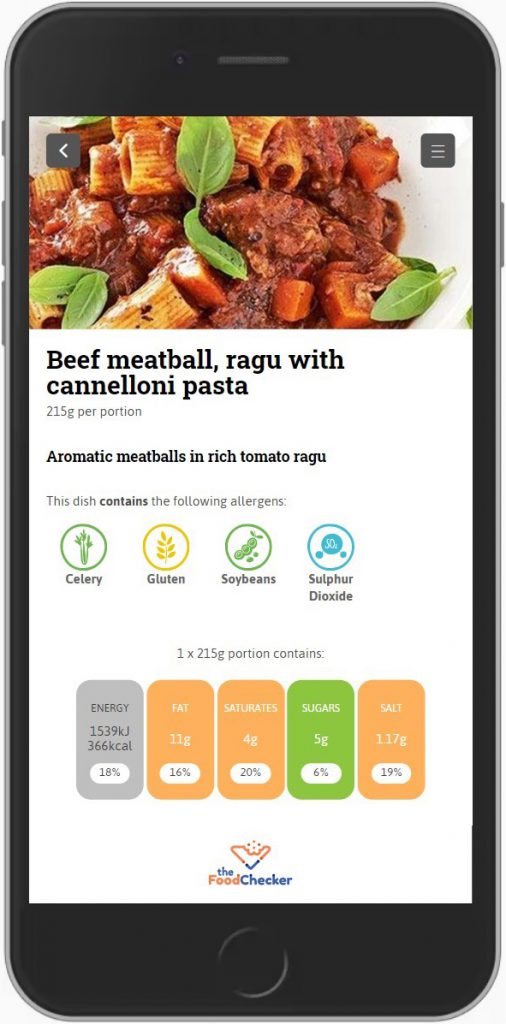Food businesses have six months to prepare for the new allergen labelling legislation, known as Natasha’s Law, which comes to effect 1st October 2021. However, many food operators feel confused and unsure what this really means to their business. Registered Dietitian, Anna-Maria Holt, explains what businesses need to know and do to comply.
What is Natasha’s Law?
2 million people are living with a diagnosed food allergy in the UK today, and 600,000 are living with Coeliac Disease, a condition which requires a strict gluten-free diet.
Natasha’s Law is intended to help those living with food allergies or intolerances to make safe choices when buying pre-packed direct sales (PPDS) food items. These foods were not previously included in the existing allergen labelling legislation (FIR, 2014)1. The parents of Natasha Ednan-Laperouse believe that her death could have been prevented if the wrapped sandwich she consumed had been labelled clearly.
Why is the new labelling legislation important?
This latest change in the legislation will ensure that consumers will receive essential information on ingredients and allergens for packaged food items produced onsite. It is hoped that the new allergen labelling legislation will prevent further deaths among those living with food allergies.
The legislation applies to all food operators across hospitality, care and education. All four UK nations are now aligned in enforcing the new legislation as Scotland also recently laid the law in Parliament3.
Under this new allergen labelling law, all food businesses selling foods categorised as pre-packed for direct sale (PPDS) must be ready to comply from 1st October 2021. This is the deadline for the implementation of the Food Information Amendment (2019)2 .
Does the new allergen law apply to your business?

Firstly, to find out if the new allergen labelling law affects your business you should establish whether any of the food you serve is categorised as PPDS.
What is pre-packed for direct sale (PPDS) food?
To determine this, you will need to answer these THREE important questions: when, where and how is the food packaged?
Food categorised as PPDS is:
- Packaged in the same place the food is offered to customers
- Placed in packaging before the food is ordered or selected
Examples of PPDS food:
- Boxed salads
- Pasta pots
- Packaged sandwiches
- Grab and Go items like paninis
- Pots of takeaway porridge
- Wrapped sausage rolls and other bakery products
Generally, any food that is wrapped or packaged before it is selected will fall under the new labelling requirements.
However, you may find that categorising the food you provide is not as straightforward because there is a grey area around which foods are in/out of scope. For example, is a wrap in an open-ended sleeve in or out of scope?
The big issue is that there is no formal legal definition for PPDS so if you do get confused you will not be alone. The Food Standards Agency (FSA) is working on producing further guidance to help the hospitality industry prepare. This will be published soon.
In the meantime, to help you identify which of the foods your business provides are PPDS, you can access the FSA’s Allergen and ingredients food labelling decision tool here.
Once you have identified which foods, if any, are PPDS, you will need to decide whether you will continue to provide them all or reduce your offer. All the PPDS foods your operation offers will need to be labelled by law.
How will the new allergen law apply to your business?
Under the new legislation, if your food business provides PPDS food, you must clearly provide the following information on a label on the food item:
- The name of the food
- Full ingredients list with allergenic ingredients emphasised
Allergenic ingredients refer to the 14 allergens, which must be declared in line with existing food law3.
The ingredient and allergen information provided on the label must be accurate and presented in a suitable format.
All ingredients found in a product must be listed, including sub-ingredients. Examples of these are the spread used in a sandwich, or the dressing on a salad.
The list of ingredients is likely to be very long on some PPDS items especially as the allergens within these lists must be emphasised.
Ingredients on the label must be listed in descending order, by weight. This will align the format used by food operators to those used in manufactured foods, giving the consumer a consistent presentation of information on food labels.
What do you need to do, to prepare?

Act now – and start by considering these three key areas:
Working with your suppliers
You will need to work collaboratively with all your suppliers to understand how they capture ingredient and allergen data, and most importantly how this will be passed on to your business.
Ask your supplier what verification checks and processes they have in place? How are discrepancies picked up?
Ingredient and allergen information
Ingredient and allergen information can be captured using third party software solutions and label printers. You will need to understand how the ingredient and allergen data is being obtained and updated. You will also need to make sure the label format is compliant with the requirements. How will the ingredient list be ordered? How will allergens be emphasised?
The labels placed on PPDS foods must be up to date with all ingredient and allergen information when put on display for the customer to select. Pre-printed labels are great if the printer breaks down but what if there is a last-minute substitution from a supplier?
Allergen data isn’t fixed and recipes for products change. Do not forget the importance of a physical label check against the data shared with you.
Training and responsibility
Everyone in your business must be fully informed and responsible for providing the correct allergen information. Ensure your staff receive training on the new requirements especially if you provide PPDS food.
The FSA offers a free online, self-directed Food allergy and Intolerance Training module, which can be accessed here.
Checklist for Catering Teams
Use the following checklist to ensure that your catering team has a full understanding of the requirements and your processes to comply with the new legislation.
- What is Natasha’s Law?
- Why is the new labelling legislation important?
- Which foods offered are PPDS?
- How many PPDS products do you offer? Are these manageable?
- What must be done to comply?
- How will ingredient and allergen information be captured?
- How will you get all the ingredient information on the labels?
- How will you manage label production?
- Can you ensure food labels are providing accurate and reliable information in the correct format?
- How will you ensure changes as a result of product substitutions are captured?
- Are your team fully informed about the new allergen labelling requirements?
- How will you support your customers to ask about allergens and the new labelling laws?
Latest technology – Allergen Management

The Pelican team have developed an online Menu and Allergen Management tool, called Piranha, to help food operators easily manage cost and allergens. The system captures the allergen data for ingredients directly from suppliers, providing an auditable trail of information. This information can be used to generate a dish or ingredient level allergen matrix, at the click of a button.
Furthermore, we have developed a new online tool called, FoodChecker, to help you quickly and easily share allergen and nutrition information with your customers. Your customers will be able to click on recipes or use QR codes to view the allergen and nutrition details easily from their phone.
Book your demo today
To book demo to see how our online solution can you help you – Contact our Pi team to book your demonstration today at hello@pelicanprocurement.co.uk
References
- The Food Information Regulation 2014 Available at https://www.legislation.gov.uk/uksi/2014/1855/pdfs/uksi_20141855_en.pdf
- The Food Information Amendment (Amendment) (England) Regulations 2019 Available at https://www.legislation.gov.uk/uksi/2019/1218/made
- Food Standards Scotland (2021) Improved allergen labelling becomes Law Available at https://www.foodstandards.gov.scot/news-and-alerts/improved-allergen-labelling-becomes-law-to-protect-consumers-in-scotland
About the Author:
Anna-Maria Holt is an HCPC registered dietitian, and a member of the BDA with over 15 years experience in working with caterers and food businesses. Through AH Dietetics, Anna-Maria offers a dietetic service in a freelance capacity to caterers in foodservice to help with nutrition, special diets and food allergen queries.









